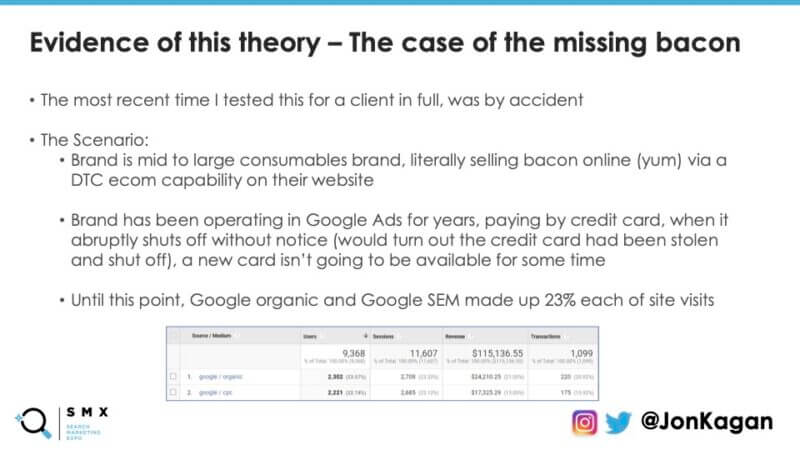“When people tell me they can pause SEM and be fine with their performance on the holistic level on their site with just the organic listings, how do I react?” Jonathan Kagan, VP of search at 9Rooftops said at SMX Next, “First of all, no, absolutely not — unless your name is eBay, which is one of the few brands that have proven that they can do it without that, it’s not going to work for you.”
When the assumption is that your organic rankings are strong enough to keep traffic stable, some brands may be tempted to cut back on paid campaigns to save money. As Kagan mentioned, that can be true for brands that are household names, but for most queries, the search results page will show a variety of domains and paid search ads can increase the amount of real estate a brand takes up on the page.
“So, it’s essentially the concept of if you see it enough times, you’re more likely to go to one [brand] than the other,” he explained. To help brands better understand what’s driving their search marketing, Kagan shared a case study about search incrementality and the steps he uses to evaluate the impact of paid campaigns working in tandem with organic efforts.
Paid and organic: More than the sum of their parts
“Assume your organic listings are operating by themselves,” Kagan said as an example, “There is no paid search present and it produces 100 visitors to your website.”
“Now, assume that you have paid search — SEM is running by itself for various keywords and you have absolutely zero organic presence and that drives 100 visitors,” he continued, noting that this scenario is more realistic for non-brand keywords.
“Theoretically, when the two of them are together, paid search and organic together should deliver 100 visitors because they’re both present for the same queries. What we actually see, however, is a degree of incrementality where it will actually exceed the original expected 100 visitors,” he said, pointing to studies by Melissa Mackey and Anindya Ghose and Sha Yang that show degrees of incrementality.

Kagan followed up this hypothetical scenario with his own case study, in which his client, a mid-sized DTC brand, inadvertently had its Google Ads account abruptly halted.

“What theoretically should have happened is if everything that we trigger for on paid search was the same that we trigger for on organic — we have really good organic rankings — then the 23% of visits that were on the organic side should rise to 42% to 46%,” he said, “What happened in reality? Instead, it only reached 36%.”

“Basically what happened was organic Google could not pick up all the visits to the site — it could not pick up all the transactions simultaneously,” he said. However, upon relaunching his client’s paid search efforts, the data returned to near-identical, pre-test levels.
How to assess your paid search incrementality
Kagan presented a straightforward approach to understanding the value of your paid search incrementality.
First, marketers must establish a benchmark by reviewing relevant KPIs (such as users, sessions or conversions) according to channel (paid or organic). “I recommend doing Bing/Yahoo organic plus Bing SEM as one entity or Google SEM and Google organic as an entity,” he said, referring to the breakdown of metrics by channel and source.
The next step is to begin the test by pausing your paid search efforts. You’ll want to suspend your SEM campaigns for one to three weeks, Kagan recommended.

During the test, it’s important to continue tracking all of the same metrics, both for organic and paid. Even though SEM metrics will likely be gone, keeping an eye on them can ensure the quality of your test results. Note any substantial changes to your metrics relative to the pre-test baseline.
After your test period, return to your normal operations by resuming your paid campaigns. Allow your organic and paid efforts to continue as usual for the same amount of time as the test period before evaluating your results: “So if you run this test for three weeks, then don’t evaluate your data until three weeks post-test,” Kagan said.
Finally, you’re ready to compare your test and post-test metrics with your benchmarks to get an overview of what performance is like without paid ads, along with the proportion of your clicks and conversions, for example, that your paid efforts are actually responsible for.

For brands that don’t see a significant decrease in their important business metrics after pausing paid campaigns, it may be worthwhile to scale back and let organic do the heavy lifting. However, that’s just simply not the case for the majority of businesses, “So there is a definite need to run organic and SEM in conjunction together for a degree of incrementality and a degree of protection,” Kagan said.
Watch the full SMX Next presentation here (free registration required).
The post Search incrementality: How paid and organic work together for better performance appeared first on Search Engine Land.
Source: Search Engine Land

